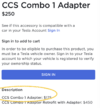Thanks for all the help and suggestions!
I am planning to go from CO Springs to Pueblo and deep charge enough to comfortably go over the pass and on to Alamosa. Then, charge deep enough to go to Durango, but will likely CCS charge in Pagosa Springs just for some additional “insurance“ charge, just in case the CCS chargers in Durango are flakey, however the plan is to CCS charge enough in Durango to hit Mesa Verde National Park on Monday! Then, back to Durango for Monday night, and go through Farmington, Gallup, Holbrook, and Payson to Phoenix on Tuesday. (Done most of those segments plenty of times.)
None of these CO segments looked to be much trouble, assuming all charging equipment is operational, but they are new to me. Plus, most of the troublesome weather will be further north, and should be more or less gone by overnight Sunday. I do still show 295 miles rated range, which is great, but I am packed to the gills, so probably close to 300 extra lbs. I think I am averaging about 350 Wh/mi for the last 1000 mi since MN.
Pueblo to Alamosa was pretty easy especially since temps were moderate and the wind was light. Charged to 92% in Pueblo just to be safe. Stayed at the speed limit and arrived in Alamosa at 32%. (2019 Model 3 LR with 295 indicated rated range)
Alamosa (the town) was surprisingly dead; minimal traffic and activity around town. Maybe that is normal there on a Sunday. Saw no other Teslas in or out of town. The lady at the nearby visitor center didn’t think the supercharger was even open yet since she had never seen a Tesla there yet. Charged to 92% again, just to be safe.
The short stretch from Alamosa to South Fork was easy, but the Wolf Creek pass was more “exciting”. The snow started to fall really hard, but luckily the highway had been plowed and salted/sanded well, so the driving wasn’t too bad. But, I would not even consider driving through that pass in a real snow storm!
Oddly enough, when we got to Pagosa Springs (just 24 miles later) the weather was sunny and beautiful! So, we plugged into one of the ChargePoint CCS chargers (just because we could) and walked along the San Juan River and watched the people enjoying the hot springs. Cool town! We added 20% while site seeing. Weirdly, there were 2 Teslas plugged into the Level 2 chargers and just sitting in their cars. (A Model Y and a newer Model S; maybe neither was CCS enabled?)
The final stretch to Durango was easy with just some light rain. Arrived at 58%. Both CCS chargers in Durango (transit center) were working fine. The drive over to (and into) Mesa Verde NP, and back to Durango, the next day only used about 52% charge, but temps did get to 50 degrees and winds were mild.
Overall, we were lucky that the storm system stayed mostly north so that only the area over about 9,000 ft. saw real snowfall for us. And that winds were not too crazy that day.
I never noticed any non-Teslas the entire day (except in Pueblo and Durango), which surprised me a little.
Definitely a good idea to deep charge in Pueblo and Alamosa for those mountainous segments, especially in winter!




